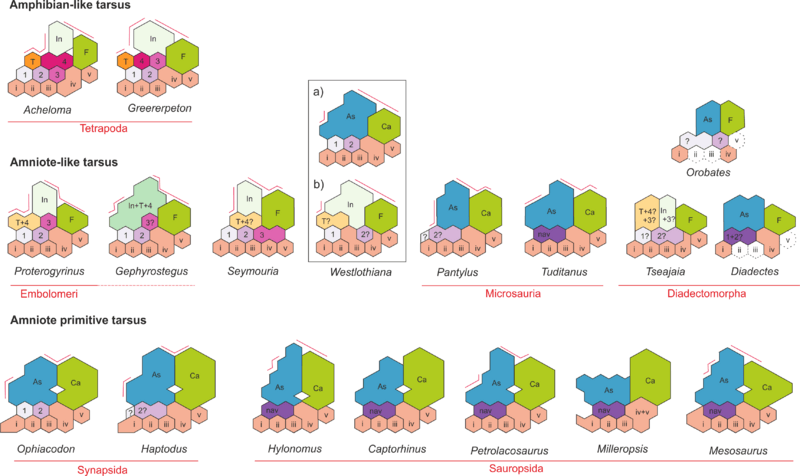Image: Reptiliomorph tarsals

Description: Figure 10: Tarsus structure in basal tetrapods, including amniote and non-amniote taxa. Schematic diagram for comparing the tarsus structure in the basal tetrapods Acheloma and Greererpeton (amphibian-like tarsus) with regard to that of embolomeres and microsaurs (amniote-like tarsus) and early amniotes. Note the similar structure and construction of the microsaur tarsus with respect to the early amniote Hylonomus. See text for more details of the evolutive significance of the selected taxa. Abbreviations: As, astragalus; Ca, calcaneum; F, fibulare; I, intermedium; T, tibiale; 1, 2, 3, 4, centralia; i, ii, iii, iv, v, distal tarsals. Taxa were redrawn from the following sources: Acheloma (Dilkes, 2015); Greererpeton (Godfrey, 1989); Proterogyrinus (Holmes, 1984); Gephyrostegus (Carroll, 1970); Seymouria (Berman et al., 2000); Westlothiana (Smithson, 1989; Smithson et al., 1994); Pantylus (Carroll, 1968); Tuditanus (Carroll, 1968); Diadectomorphs (Moss, 1972; Berman & Henrici, 2003); Ophiacodon and Haptodus (Romer & Price, 1940); Hylonomus (Carroll, 1964); Captorhinus (Fox & Bowman, 1966); Petrolacosaurus (Peabody, 1952; Reisz, 1981).
Title: Reptiliomorph tarsals
Credit: Piñeiro G, Núñez Demarco P, Meneghel MD. (2016) The ontogenetic transformation of the mesosaurid tarsus: a contribution to the origin of the primitive amniotic astragalus. PeerJ 4:e2036 [1]
Author: Graciela Piñeiro, Pablo Núñez Demarco, Melitta D. Meneghel
Usage Terms: Creative Commons Attribution 4.0
License: CC BY 4.0
License Link: https://creativecommons.org/licenses/by/4.0
Attribution Required?: Yes
Image usage
The following page links to this image:

